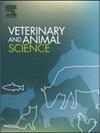Investigating BoLA Class II DRB3*009:02 carrying cattle in Japan
IF 1.9
Q2 AGRICULTURE, DAIRY & ANIMAL SCIENCE
引用次数: 0
Abstract
Enzootic bovine leukosis (EBL) is a malignant lymphoma of cattle that is mainly caused by bovine leukemia virus (BLV) infection. In this study, PCR-RFLP was used to investigate the frequency of the DRB3*009:02 allele in several farms with different herd management practices in Japan. A total of 742 Holsteins (384) and Japanese Blacks (230) were used as the sample size for the study, which was larger than the number of cattle in the study area with a confidence level of 95 % and a margin of error of 8. PBMCs isolated from whole blood from clinically healthy cattle were used for examination. The presence of BLV provirus infection was determined by qPCR targeting the env region. BLV antibodies were detected using a commercial ELISA kit. The results showed that 35 cattle were heterozygous for DRB3*009:02. The frequency on each farm varied between farms, and PCR analysis showed that the prevalence of BLV also varied between farms. The incidence rate (4.7 %) was lower than in previous studies. The BLV seroprevalence (14.4 %) in this study was lower than the BLV infection rate (35 %) in the study. Holstein dairy cows had low levels of BL resistance genes, confirming the spread of the virus within the farm's herd. Cattle on farms with low BLV-positive rates had a resistance gene-carrying rate of 16.9 %, meanwhile, those who did not carry the resistance gene had a rate of 91.4 %. BLV provirus levels vary between farmers, with herds carrying low BL-resistance genes tending to have higher levels of BLV provirus. In light of the current BLV epidemic, herd composition reform, along with aggressive breeding of BL-resistant sires, is a required component to increase the herd of BL-resistant sires and improve livestock productivity.

调查在日本携带牛只的BoLA II类DRB3*009:02。
牛地方性白血病(EBL)是牛的一种恶性淋巴瘤,主要由牛白血病病毒(BLV)感染引起。本研究采用PCR-RFLP方法调查了日本不同牧群管理方式猪场中DRB3*009:02等位基因的频率。采用742头荷斯坦牛(384头)和230头日本黑牛(230头)作为研究的样本量,其置信度为95%,误差范围为8。从临床健康牛全血中分离PBMCs进行检测。采用针对env区的qPCR检测BLV病毒感染。使用商用ELISA试剂盒检测BLV抗体。结果表明,35头牛为DRB3*009:02杂合。每个养殖场的频率不同,PCR分析显示BLV的流行率在养殖场之间也存在差异。发病率(4.7%)低于既往研究。本研究中BLV血清阳性率(14.4%)低于BLV感染率(35%)。荷斯坦奶牛的BL抗性基因水平较低,证实了该病毒在农场牛群中的传播。blv阳性率低的养殖场携带抗性基因率为16.9%,未携带抗性基因的养殖场携带抗性基因率为91.4%。BLV原病毒水平因农民而异,携带低BLV抗性基因的畜群往往具有较高的BLV原病毒水平。鉴于目前BLV的流行,畜群组成改革以及BLV抗性品种的积极育种是增加BLV抗性品种种群和提高牲畜生产力的必要组成部分。
本文章由计算机程序翻译,如有差异,请以英文原文为准。
求助全文
约1分钟内获得全文
求助全文
来源期刊

Veterinary and Animal Science
Veterinary-Veterinary (all)
CiteScore
3.50
自引率
0.00%
发文量
43
审稿时长
47 days
 求助内容:
求助内容: 应助结果提醒方式:
应助结果提醒方式:


